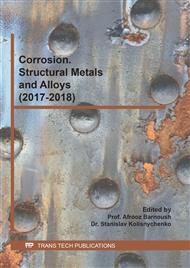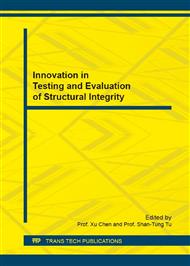[1]
W. Maeng, J. Lee, U. Kim, Environmental effects on the stress corrosion cracking susceptibility of 3. 5NiCrMoV steels in high temperature water, Corros. Sci., 47 (2005) 1876-1895.
DOI: 10.1016/j.corsci.2004.09.022
Google Scholar
[2]
P.B. Srinivasan, W. Dietzel, R. Zettler, J.F.D. Santos, V. Sivan, Stress corrosion cracking susceptibility of friction stir welded AA7075–AA6056 dissimilar joint, Mater. Sci. Engin. A, 392 (2005) 292-300.
DOI: 10.1016/j.msea.2004.09.065
Google Scholar
[3]
P.B. Srinivasan, V. Muthupandi, W. Dietzel, V. Sivan, An assessment of impact strength and corrosion behaviour of shielded metal arc welded dissimilar weldments between UNS 31803 and IS 2062 steels, Mater. Des., 27 (2006) 182-191.
DOI: 10.1016/j.matdes.2004.10.019
Google Scholar
[4]
H.C. Ma, Z.Y. Liu, C.W. Du, H.R. Wang, X.G. Li, D.W. Zhang, Z.Y. Cui, Stress corrosion cracking of E690 steel as a welded joint in a simulated marine atmosphere containing sulphur dioxide, Corros. Sci., 100 (2015) 627-641.
DOI: 10.1016/j.corsci.2015.08.039
Google Scholar
[5]
G.F. Li, E.A. Charles, J. Congleton, Effect of post weld heat treatment on stress corrosion cracking of a low alloy steel to stainless steel transition weld, Corros. Sci., 43 (2001) 1963-(1983).
DOI: 10.1016/s0010-938x(00)00182-7
Google Scholar
[6]
R. Nishimura, Characterization and perspective of stress corrosion cracking of austenitic stainless steels (type 304 and type 316) in acid solutions using constant load method, Corros. Sci., 49 (2007) 81-91.
DOI: 10.1016/j.corsci.2006.05.011
Google Scholar
[7]
R. Nishimura, J. Shirono, A. Jonokuchi, Hydrogen-induced cracking of pure titanium in sulphuric acid and hydrochloric acid solutions using constant load method, Corros. Sci., 50 (2008) 2691-2697.
DOI: 10.1016/j.corsci.2008.06.037
Google Scholar
[8]
R. Nishimura, T. Yoshida, Stress corrosion cracking of Cu–30% Zn alloy in Mattsson's solutions at pH 7. 0 and 10. 0 using constant load method – A proposal of SCC mechanism, Corros. Sci., 50 (2008) 1205-1213.
DOI: 10.1016/j.corsci.2007.09.010
Google Scholar
[9]
S. Barella, M. Bellogini, M. Boniardi, S. Cincera, Failure analysis of a steam turbine rotor, Engin. Fail. Anal., 18 (2011) 1511-1519.
DOI: 10.1016/j.engfailanal.2011.05.006
Google Scholar
[10]
K.B. Deshpande, Numerical modeling of micro-galvanic corrosion, Electro. Acta, 56 (2011) 1737-1745.
DOI: 10.1016/j.electacta.2010.09.044
Google Scholar
[11]
S. Weng, Y.H. Huang, F.Z. Xuan, L.H. Luo, Correlation between Microstructure, Hardness and Corrosion of Welded Joints of Disc Rotors, Proc. Engin., 130 (2015) 1761-1769.
DOI: 10.1016/j.proeng.2015.12.325
Google Scholar
[12]
A. Turnbull, S. Zhou, Pit to crack transition in stress corrosion cracking of a steam turbine disc steel, Corros. Sci., 46 (2004) 1239–1264.
DOI: 10.1016/j.corsci.2003.09.017
Google Scholar



